Home / How to Use a pKa Table
Acid Base Reactions
How to Use a pKa Table
Last updated: July 3rd, 2025 |
A Key Skill – How To Use A pKa Table
Today we’ll talk about an incredibly important skill that might take some time to grasp but pays tremendous dividends. We’ll go through the exact details of how to use pKa values to tell if an acid base reaction is favorable or unfavorable.
- pKa is the negative logarithm of the acid dissociation constant, Ka, which can be measured experimentally.
- pKa values have been measured for a large number of molecules and are largely related to the most acidic functional group present in the molecule. A pKa table is a useful complication of pKa values.
- A low value of pKa (e.g. -10) indicates a strong acid. A high value of pKa (e.g. 50) indicates a weak acid.
- Acid base reactions have four components: an acid and a base exchange a bond to H to give a conjugate acid and a conjugate base.
- Acid-base reactions can always be written as equilibria; that is, occurring in a forward or a reverse direction. The favored direction for an acid-base reaction is when a stronger acid and a stronger base give a weaker acid and a weaker base.
- One can tell which direction is favored by comparing the pKa of the acid and the conjugate acid. Formation of the weaker acid (i.e. molecule with the higher pKa) will be favored.
- These concepts can also be applied to other reactions you will learn about later on in the course (e.g. substitution reactions)
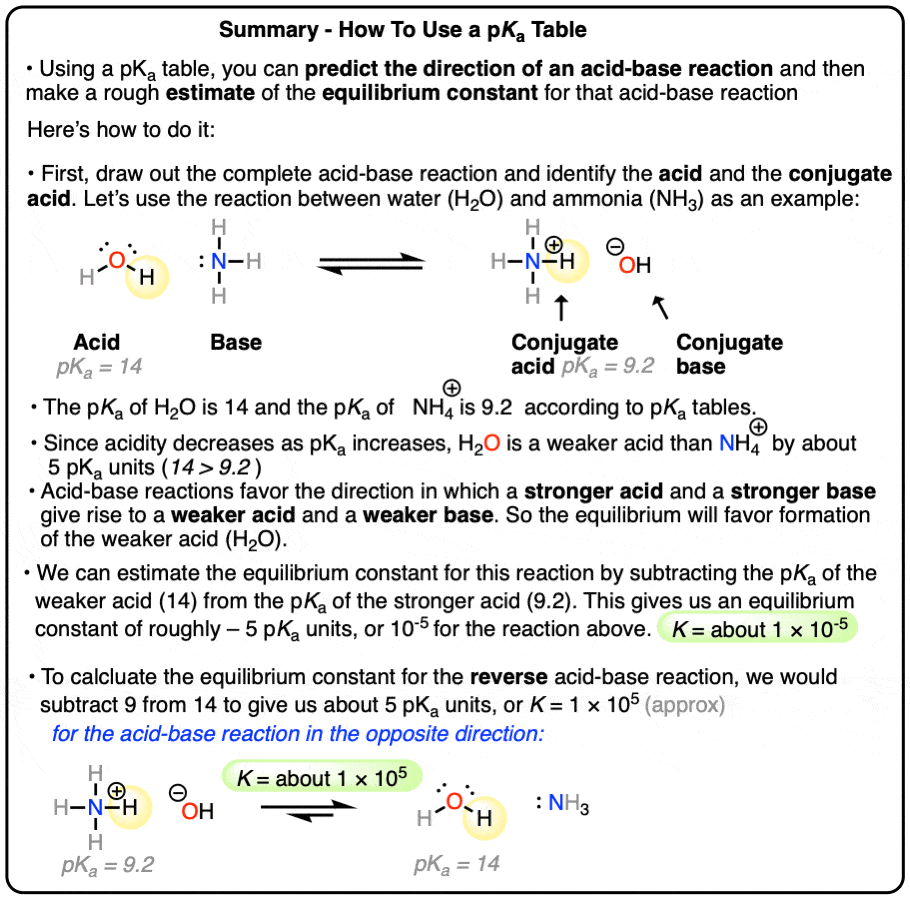
Table of Contents
-
- The Acidity Constant Ka and Its Negative Logarithm pKa
- The Four Components of an Acid Base Reaction
- The Principle of Acid-Base Mediocrity
- Using pKa values and the Principle of Acid-Base Mediocrity To Predict Acid-Base Reactions
- How to Use pKa Values to Determine Basicity
- How to Use a pKa Table To Determine If An Acid-Base Reaction Is Favorable
- How To Determine The Acidity of Compounds That Aren’t On A pKa Chart
- Applying pKa In Substitution Reactions
- Summary
- Notes
- Quiz Yourself!
- (Advanced) References and Further Reading
1. The Acidity Constant Ka and Its Negative Logarithm pKa
Let’s review some key principles of acidity constants to make sure we’re all on the same page.
The acidity constant, Ka, is a measurement of the equilibrium between an acid, H-A and its dissociation to give H+ and its conjugate base, A(-). (This value has to be measured experimentally).
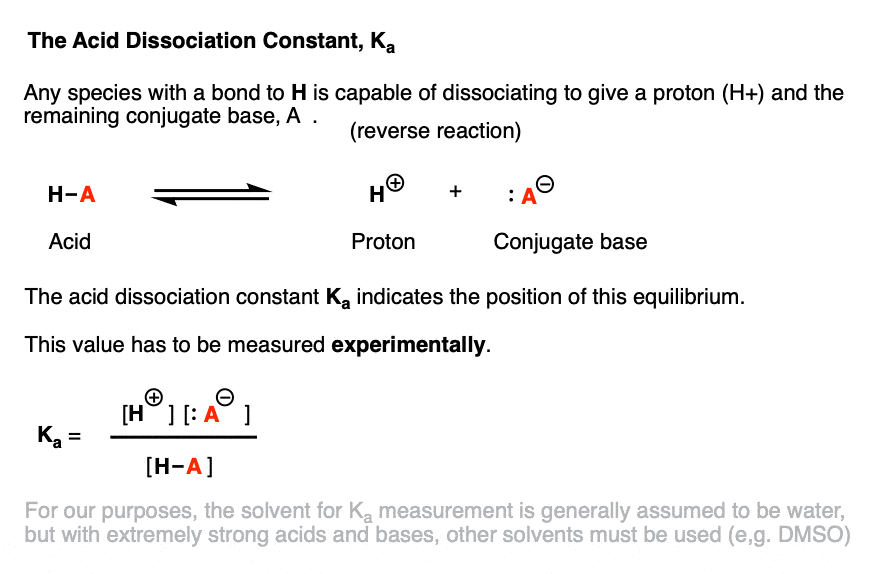
-
-
- A strong acid has complete or nearly complete dissociation, so a large Ka.
- A weak acid has incomplete dissociation, and a small Ka.
-
Not shown in the equation for Ka is the solvent, which is generally assumed to be water for our purposes. There are limits to using water as a solvent for Ka measurements at extreme acidities and basicities. [Note 1]
Can you tell which acid is stronger based on its Ka?
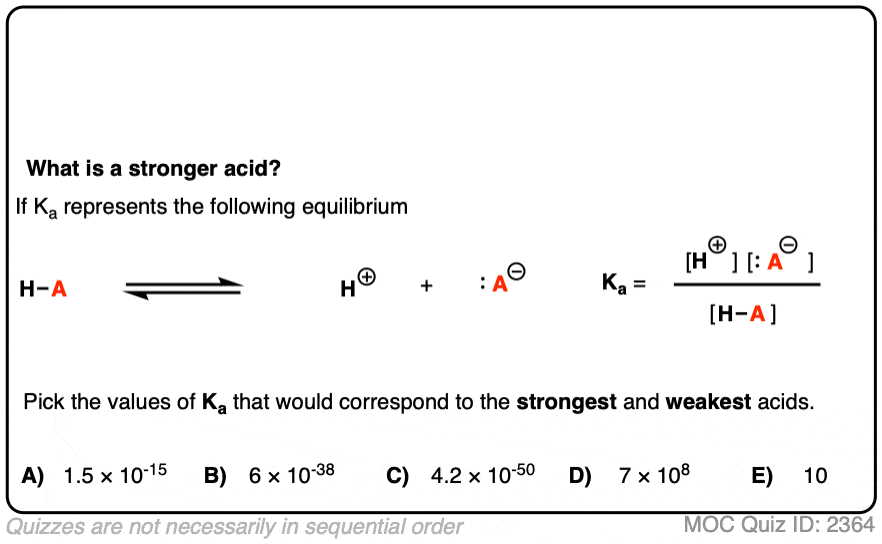 Click to Flip
Click to Flip
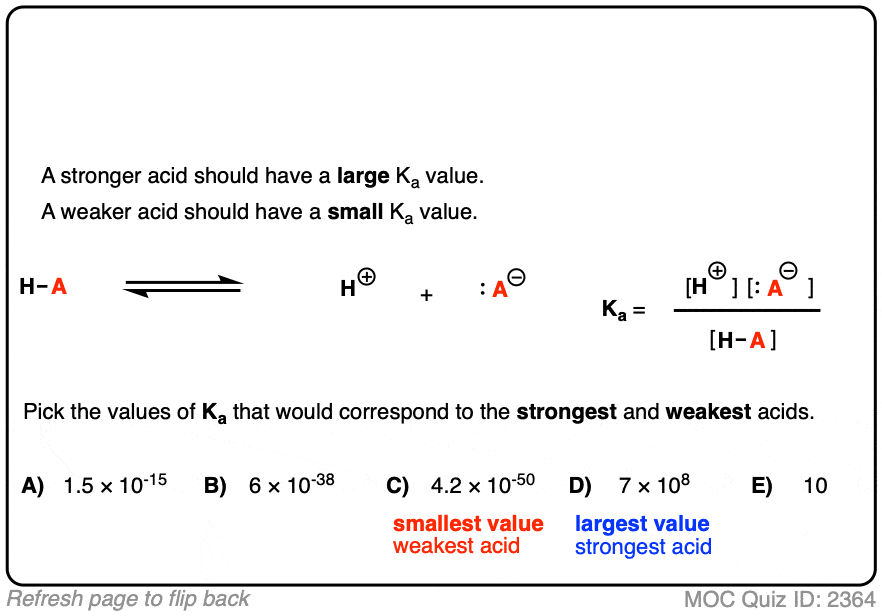
In order to get a better grasp on these numbers, we often take the negative logarithm of the acidity constant and call this pKa.
pKa = – log Ka
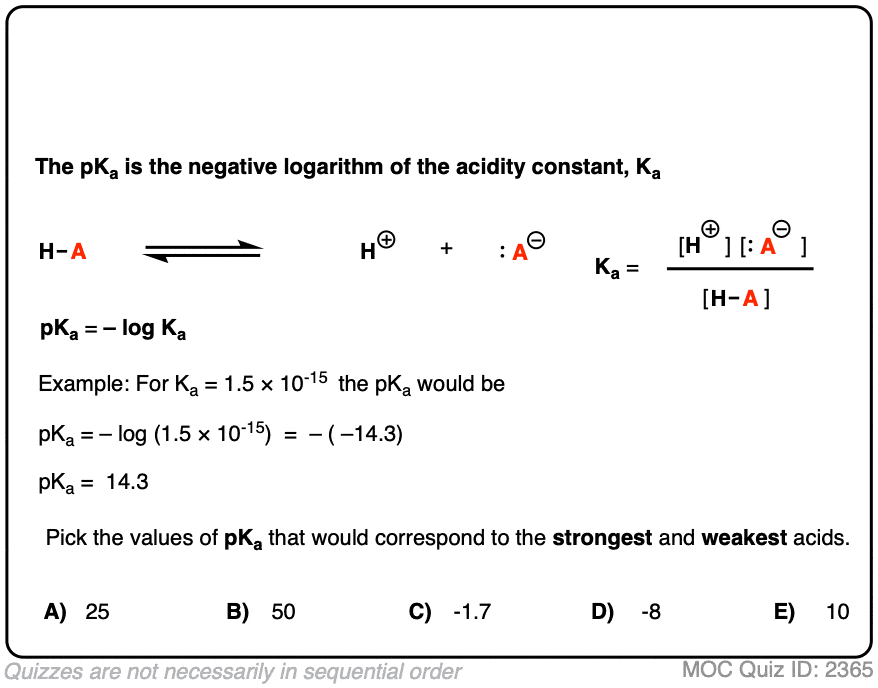 Click to Flip
Click to Flip
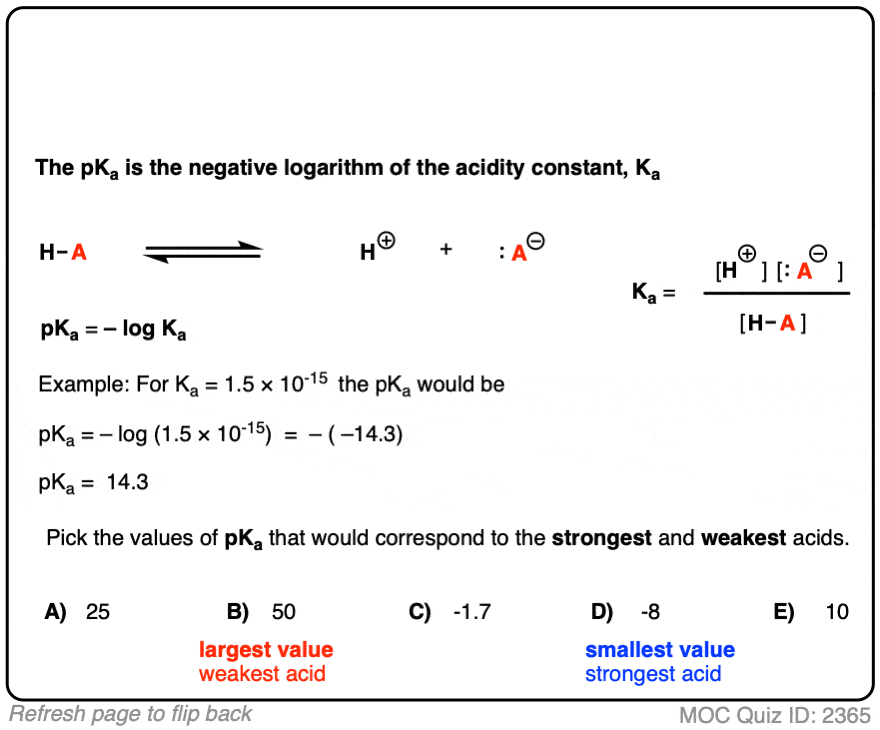
-
-
- The higher the pKa, the weaker the acid.
- The lower the pKa, the stronger the acid.
-
One of the strongest acids, H-I has a pKa of -10.
Water has a pKa of 14. [Note 2]
Alkanes have a pKa of about 50.
[Note 3]
2. The Four Components Of An Acid-Base Reaction
In an acid-base reaction, a bond is formed at H and a bond is broken at H.
Every acid-base reaction has four components.
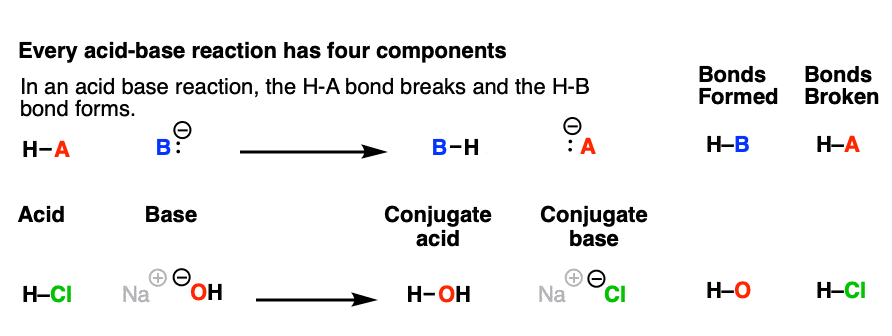
-
-
- The acid (where the bond to H breaks),
- the base (where the bond to H forms),
- the conjugate acid (the species that results when the base forms the new bond to H)
- and the conjugate base (the species that results when the acid breaks its bond to H).
-
This is drawn in the forward direction (left to right) but the reverse reaction (right to left) is also an acid-base reaction. We just flip around the identities.
To see the reverse acid-base reaction, hover here or click this link.
Note that by drawing something up as an acid-base reaction does not imply that it actually happens at a reasonable rate.
That can only be determined through experiment.
We’re just saying that the pattern of an acid-base reaction is followed (i.e. form and break a bond at the same H).
3. The Principle of Acid-Base Mediocrity
In what direction do you think acid-base reactions are favored?
Do they spontaneously go from stronger acids to weaker acids, or do they go from weaker acids to stronger acids?
What correlates more with your experience: does adding salt (NaCl) to water result in harmless salt water, or result in the exothermic formation of HCl gas and caustic NaOH?
Acid base reactions spontaneously proceed in a direction that gives weaker acids from stronger acids
I like to call this The Principle of Acid-Base Mediocrity. [Note 4]
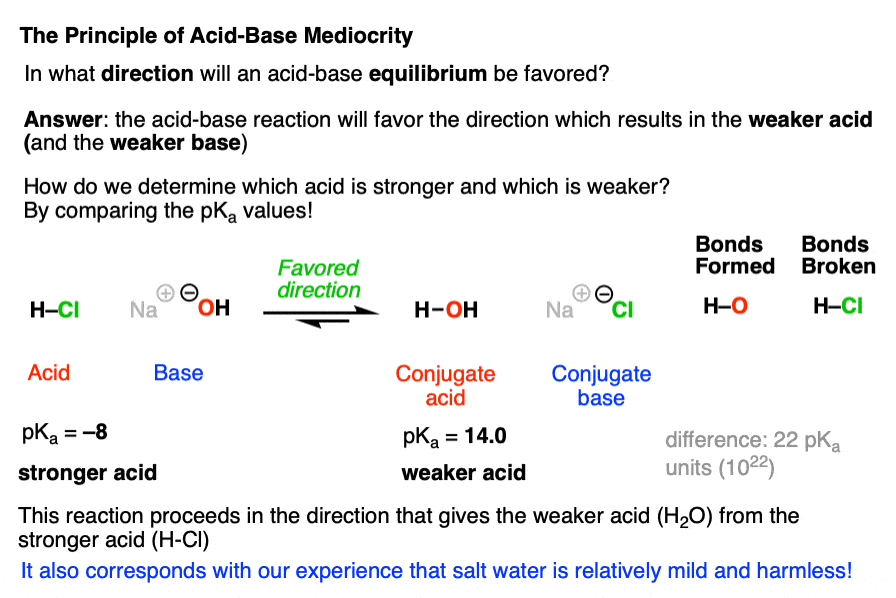
How do we know which acid is stronger and which is weaker? By identifying the acid and the conjugate acid, and comparing their two pKa values!
Acid base reactions will favor formation of the acid with the higher pKa value. It’s not completely unlike how areas of high pressure will flow to areas of low pressure.
4. Using pKa values and the Principle of Acid-Base Mediocrity To Predict Acid-Base Reactions
With these two mental tools – the higher the pKa, the weaker the acid, and the Principle Of Acid Base Mediocrity, we are all set to use pKa values to predict the directions of acid-base reactions.
The acid-base reaction that results in a compound with a lower pKa going to a higher pKa will be favored.
The compound with the lower pKa will be the stronger acid and the compound with the higher pKa will be the weaker acid.
Ready for some quizzes?
Let’s start with an acid base reaction involving a terminal alkyne (pKa 25) and acetic acid (pKa 4)
[
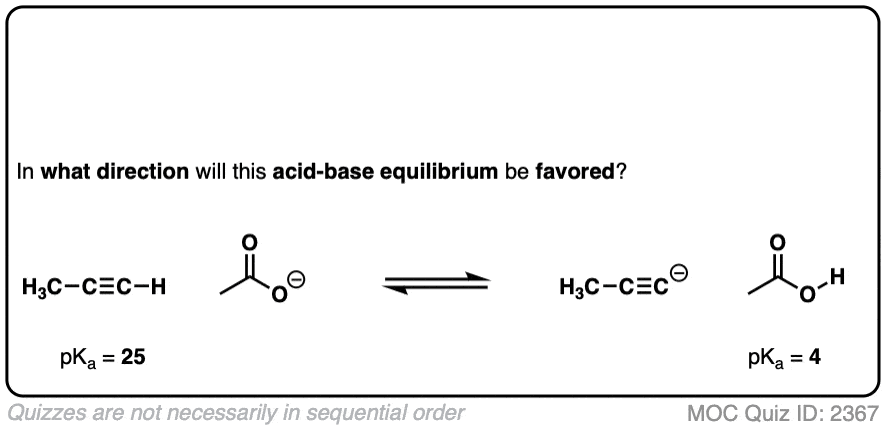 Click to Flip
Click to Flip
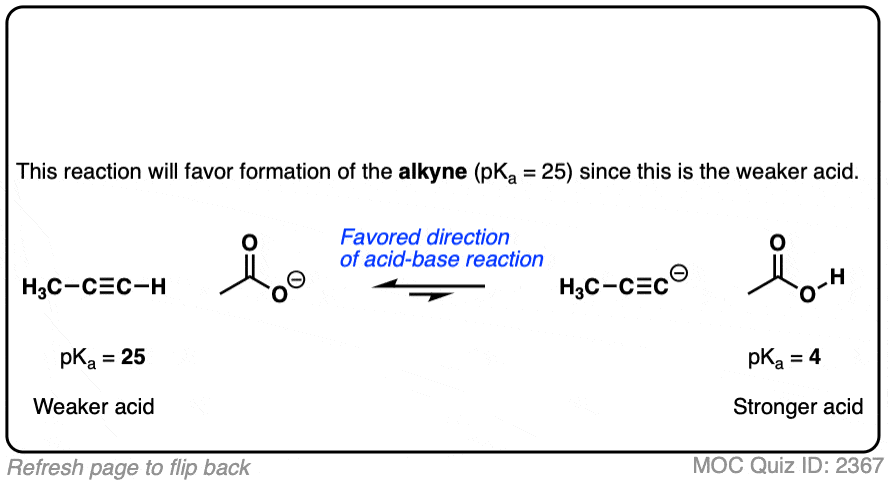
Now let’s look at water (pKa 14) and acetic acid (pKa 4)
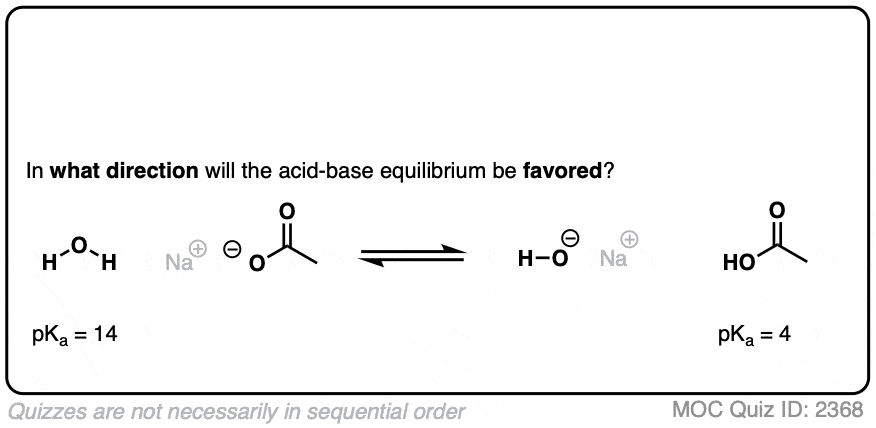 Click to Flip
Click to Flip
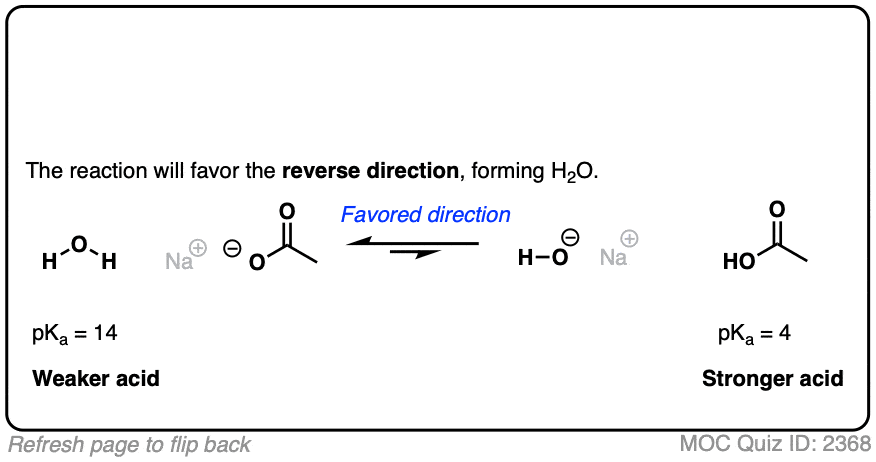
Note that each unit of difference in pKa indicates an order of magnitude difference in acidity.
We can get a rough idea of the position of the equilibrium by measuring the difference in pKa values.
So the acid-base reaction in the quiz above favors water (pKa 14) by about 10 orders of magnitude (1010) over acetic acid (pKa 4). That means there are roughly 10 billion molecules of water for every molecule of acetic acid.
This quiz asks you to calculate the ratio of each acid present at equilibrium.
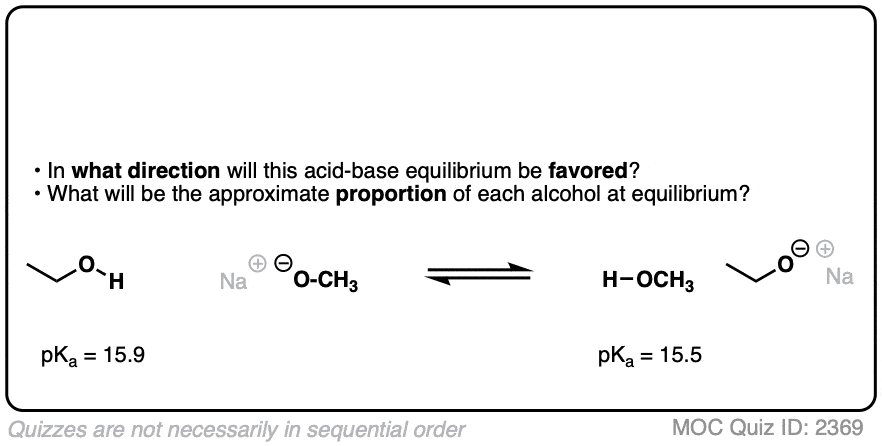 Click to Flip
Click to Flip
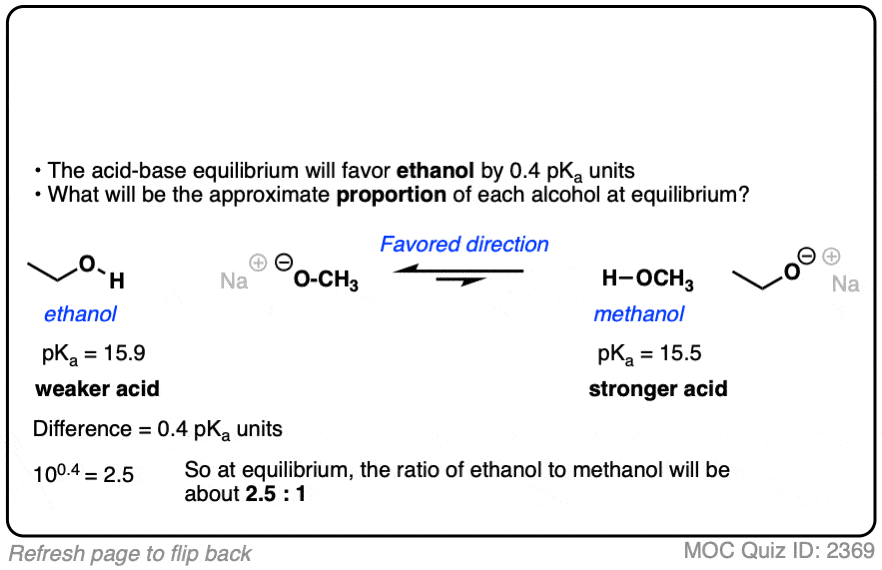
A good rule of thumb is that a difference in pKa of more than 10 pKa units will represent an irreversible acid-base reaction for the purposes of carrying out a chemical reaction. [Note 5]
So acetate ion (the conjugate base of acetic acid, pKa 4) is perfectly capable of deprotonating water (pKa 14) but the equilibrium will be very unfavorable (a difference of 10 pKa units).
It’s unreasonable to expect that acetate ion will be able to deprotonate a ketone like acetone (pKa 17) to any significant extent.
5. pKa Values Are Also A Guide To Basicity
pKa values are also a useful guide to basicity, but maybe not in the way that you’d normally think.
There’s one common misconception that needs to get cleared up.
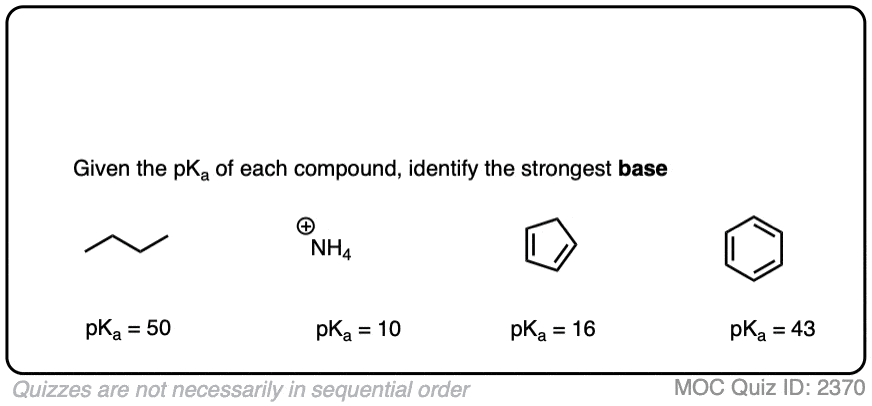 Click to Flip
Click to Flip
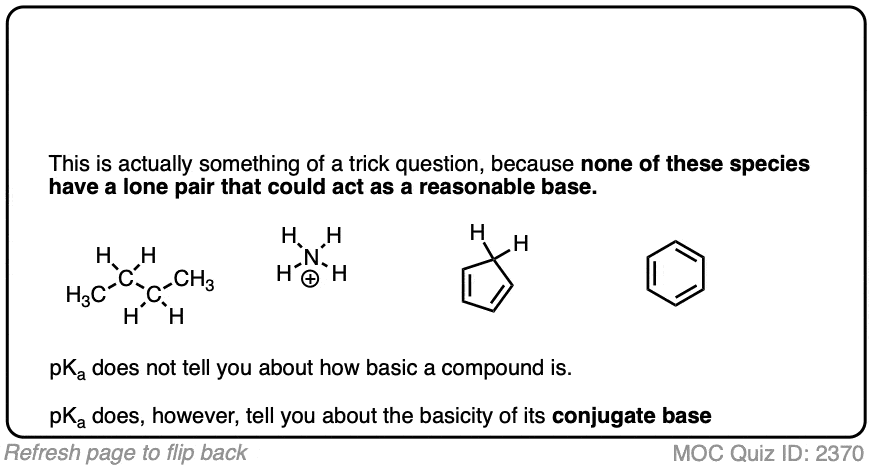
It’s true that the higher the pKa, the weaker the acid.
Does that mean that the higher the pKa, the stronger the base?
No!
In order for a species to act as a base, it has to have a lone pair of electrons that could reasonably remove a proton. That’s not the case for alkanes (pKa = 50), alkenes (pKa = 42), or ammonium salts (pKa = 10) and many others.
Instead, it’s true that the higher the pKa, the stronger the conjugate base.
You can use pKa values to predict the strength of the base that will result when a proton (H+) is removed.
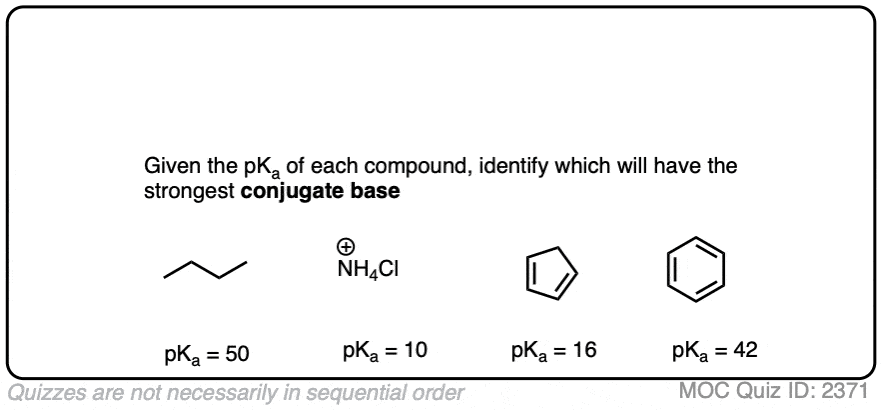 Click to Flip
Click to Flip
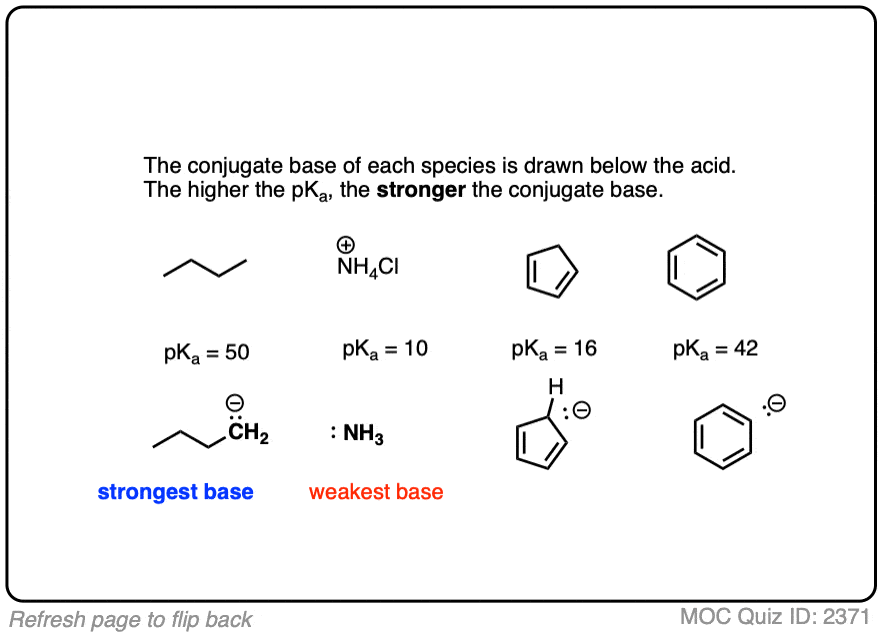
Here is another quick quiz:
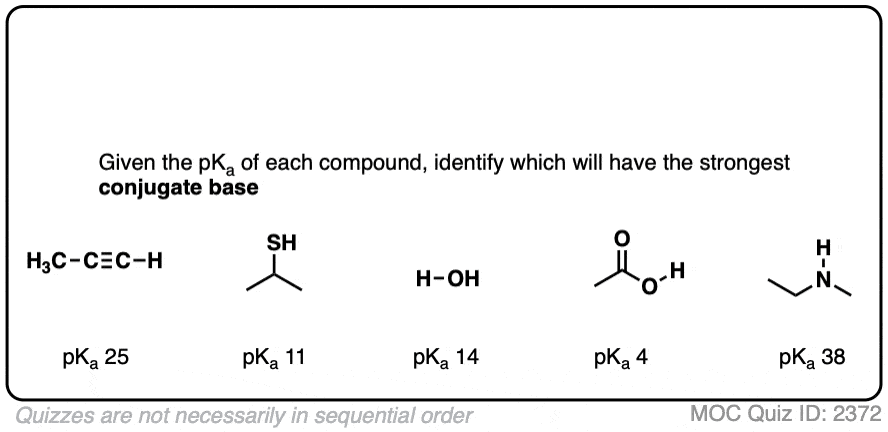 Click to Flip
Click to Flip
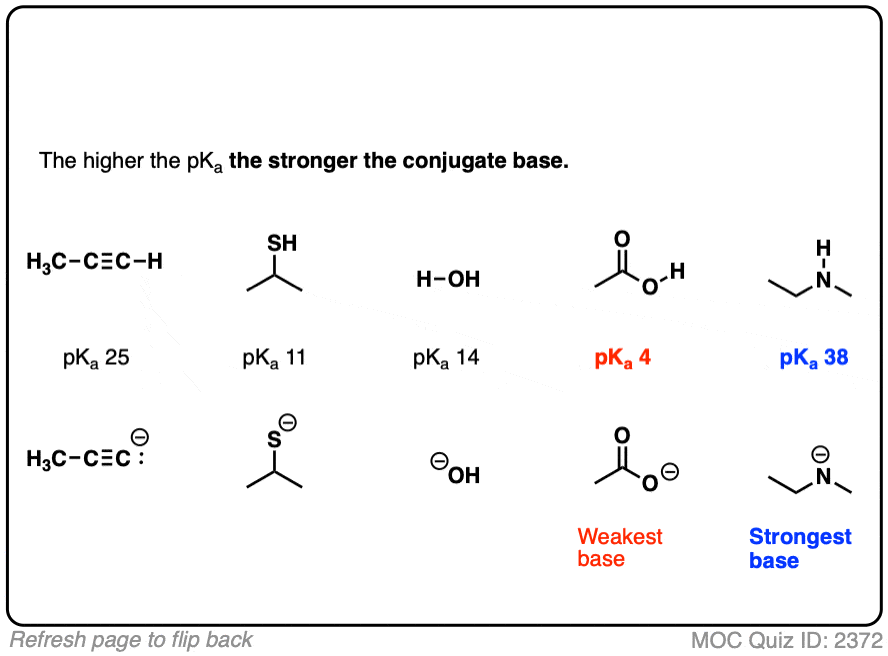
6. How To Use a pKa table
The ultimate guide to acidity is a pKa table, which represents a collection of actual measurements of the acidity of various molecules.
A typical pKa table covers the acidity of species ranging from hydroiodic acid H-I (pKa = -9) to alkanes (pKa = 50) representing about 60 orders of magnitude in reactivity. [Note 6]
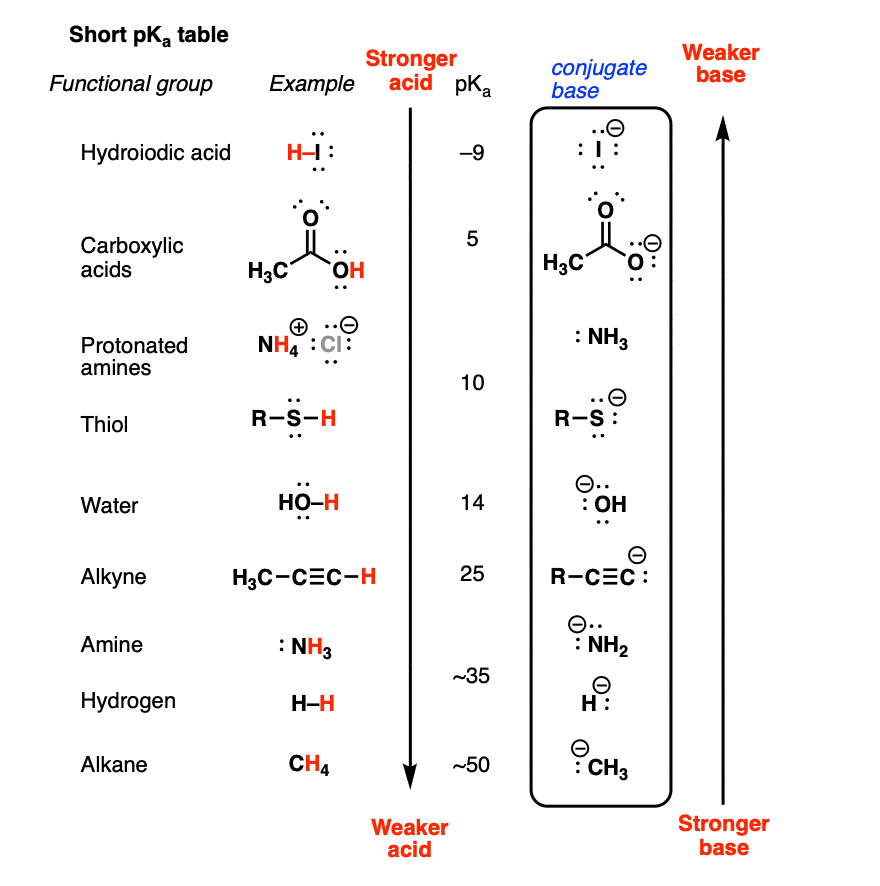
Using a pKa table, you can apply the Principle of Acid-Base Mediocrity and examine any random acid base reaction, once you have identified the main functional group.
It’s very powerful.
For example, will CH3CH2S(-), the conjugate base of ethanethiol deprotonate hydrogen gas (H2) to give H(-) ?
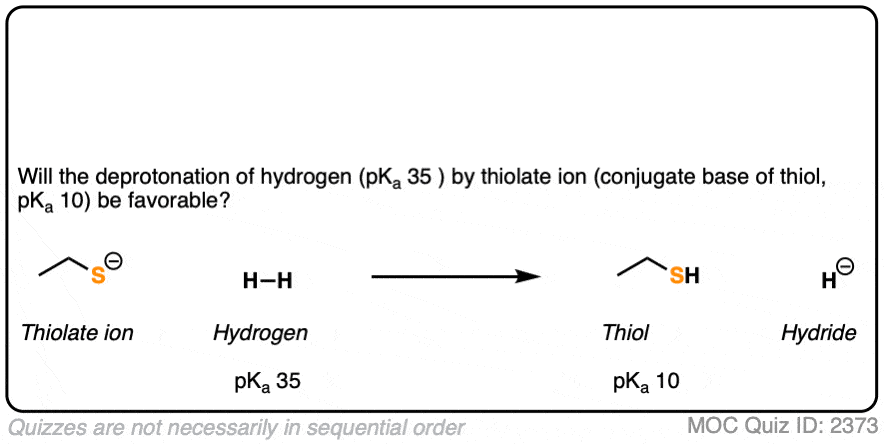 Click to Flip
Click to Flip
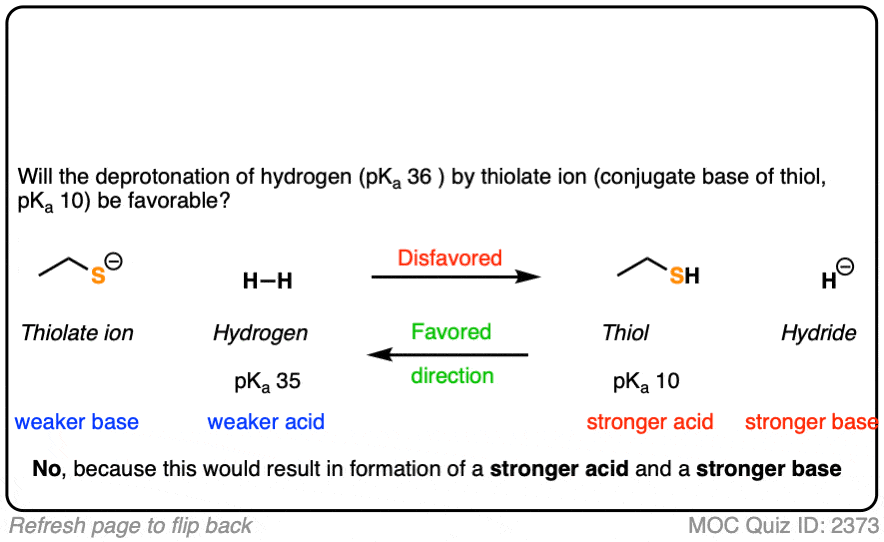
To figure this out, we draw out the four components of our acid base reaction. We then look on our pKa table for the pKa of a thiol and H2 . The pKa of the thiol is about 10 and the pKa of H2 is about 35.
Since going from CH3CH2S(-) to H(-) would result in a significantly stronger acid (and stronger base), we can say this reaction is unfavorable.
With a little bit of thought, you will soon reach the conclusion that a pKa table is not unlike the ranking of hands in poker.
It is particularly useful for ranking the strengths of bases.
For example, just like a royal flush beats all other hands in poker, a deprotonated alkane like CH3(-) will have a favorable acid-base equilibrium for the deprotonation of anything below it in the pKa table.
Since pretty much everything is less acidic than an alkane, this means that the conjugate base of an alkane can remove a proton from a huge variety of functional groups. [Note 7]
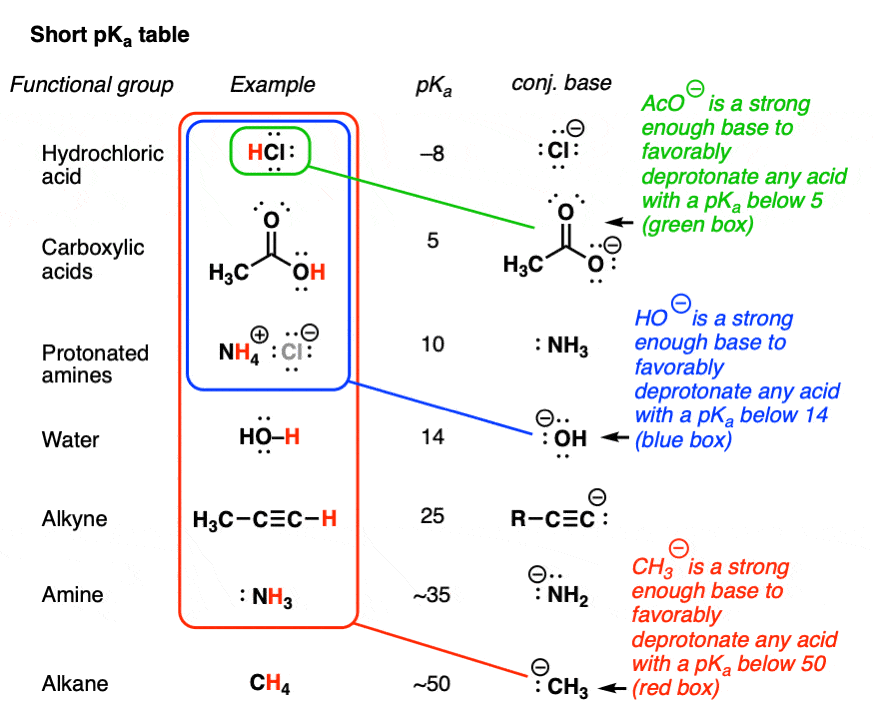
7. How To Determine The Acidity Of Compounds That Aren’t on the pKa chart
One of the keys to using a pKa table is to start by identifying the key functional group(s) present and be familiar with their acidities.
Two of the molecules below might look a little scary because they are so huge and complex, but their acidity will mostly be determined by the functional group, not all the alkyl carbons.
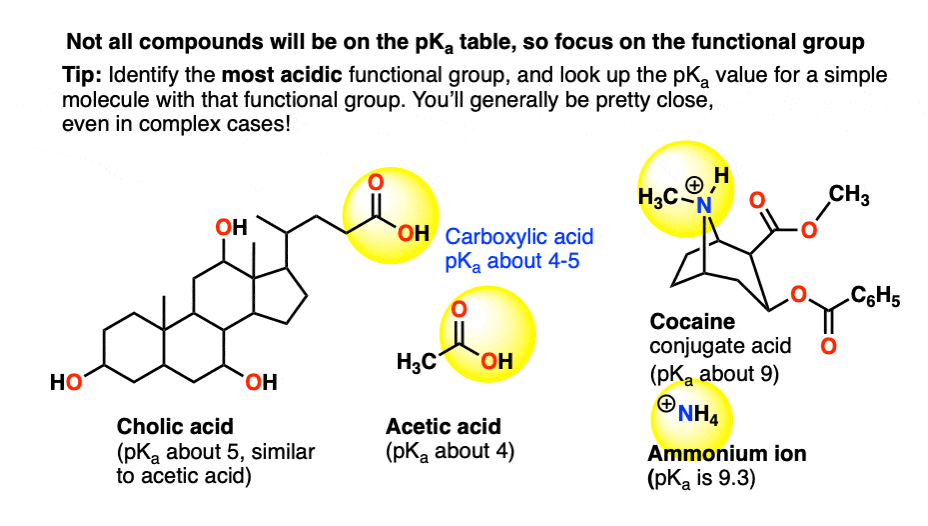
The pKa of cholic acid isn’t so different from acetic acid. The pKa of cocaine’s conjugate acid isn’t so different from ammonium. So start by focusing on the most acidic functional group.
What about the key trends that influence acidity? Aren’t they important?
Yes, of course. But when we’re changing two or more variables at once (e.g. when we’re comparing the acidities of two different functional groups), it’s difficult to judge which variable is more important without an experimental measurement.
That’s why pKa measurements are so useful.
If we’re examining the same functional group, then applying trends to determine the relative acidities is helpful.
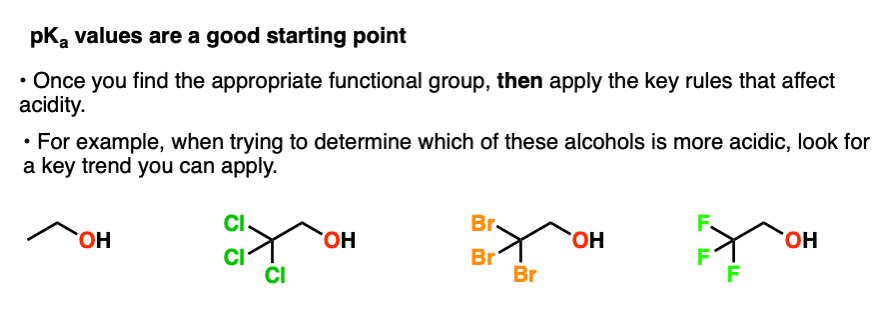
In this case, apply the trend that the more electronegative electron-withdrawing groups help to stabilize the negative charge in the conjugate base. The weaker the conjugate base, the stronger the acid.
8. Not Just For Acid Base Reactions
A good working knowledge of pKa isn’t just useful for acid-base reactions.
It can also be useful for predicting whether certain reactions will be favorable, even if you don’t know the mechanism.
For example, substitution reactions involve formation and breakage of bonds at a carbon atom.
Here is an example.
Just based on relative basicities, in which direction would you predict this reaction to be favorable? Don’t worry about anything else for now.
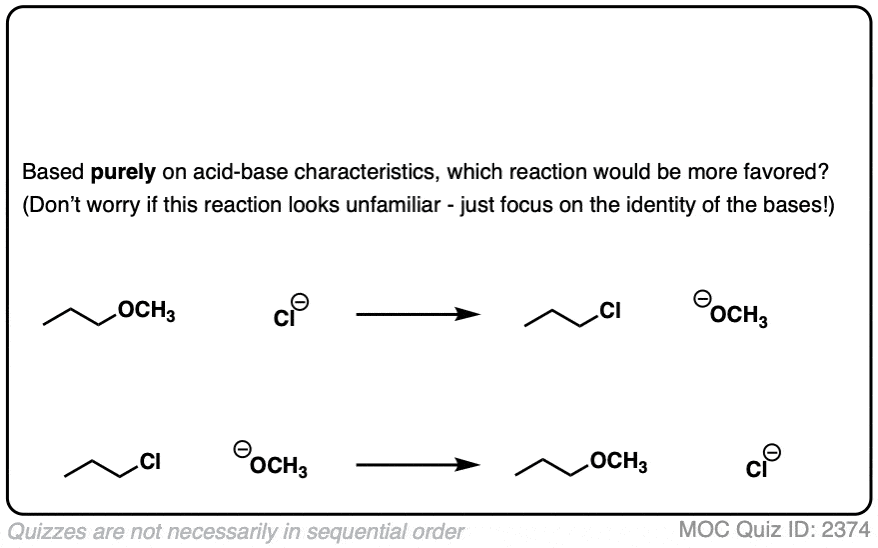 Click to Flip
Click to Flip
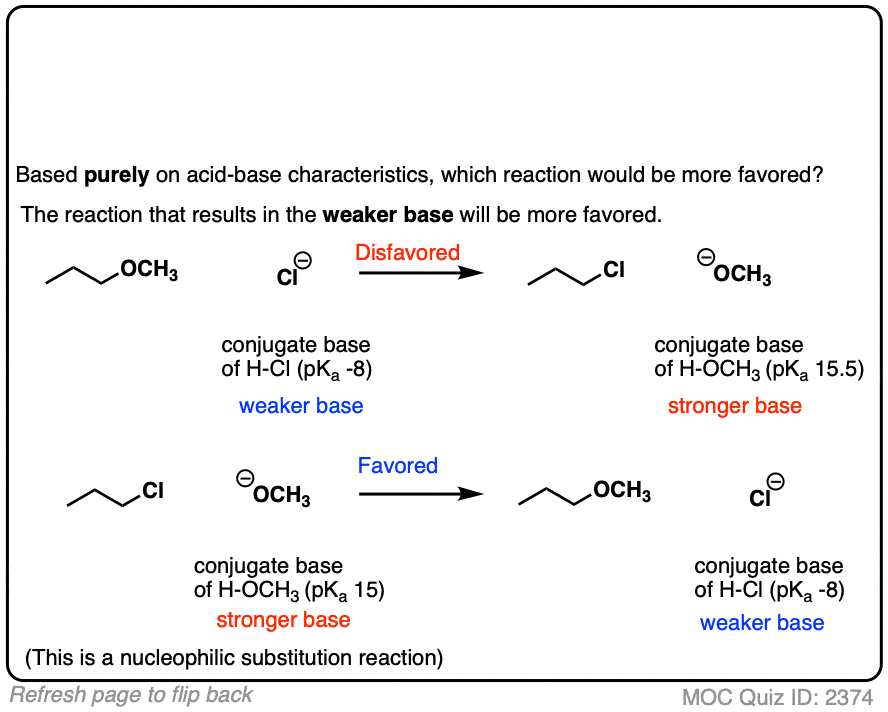
We would not expect this reaction to be favorable, because it results in a much stronger base.
But the reverse reaction, where it does form a weaker base, works perfectly fine.
Here is another examnple of a substitution reaction, known as nucleophilic acyl substitution. Don’t worry about the name or the mechanism for now.
Just based on relative pKa values, in which direction would you predict this reaction to be favorable?
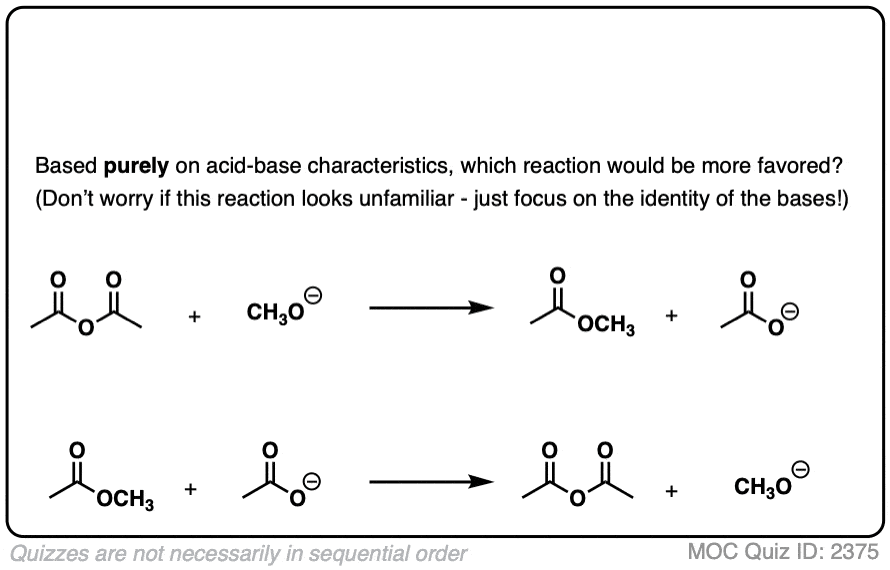 Click to Flip
Click to Flip
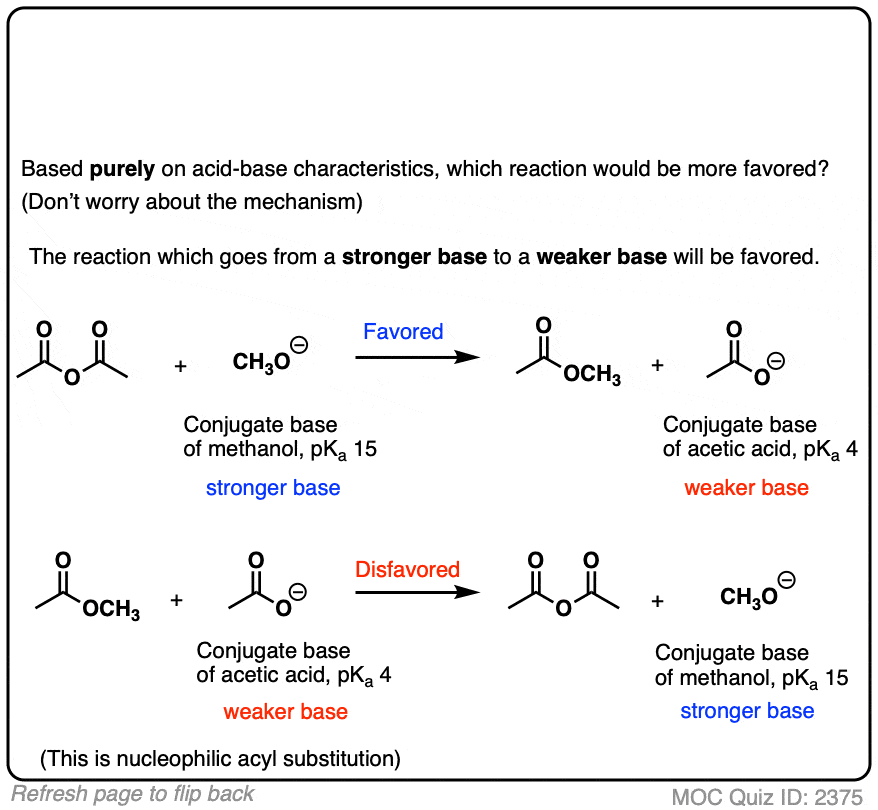
All else being equal, we should expect that the reaction will favor the formation of the weaker base.
9. Summary
If you have a pKa table, you essentially have a ranking of the stabilities of different molecules. (The stronger the base, the more unstable it is).
You can start to make predictions about which direction reactions will be favorable (or unfavorable).
When you hear instructors say things like, “don’t memorize, learn the concepts! “, this is one of those concepts that is extremely powerful when you understand it and apply it.
Notes
Related Articles
Note 1. The limit to using water as solvent for pKa measurements is the levelling effect. That is, no base can exist that is stronger than HO(-), and no acid can exist that is stronger than H3O(+). For this reason, pKa values for weaker acids than H2O are often measured in DMSO.
Note 2. The pKa of pure water is 14. The relative acidity of water relative to alcohols can change in other solvents. For example, in 2-propanol, methanol is 3 times more acidic than water. See Ref 1.
Note 3. How are pKa values measured? See reference six.
Note 4. Related to the Principle of Acid-Base Mediocrity is the Principle of Pressure Mediocrity (high pressure flows to low pressure, to give a mediocre pressure) and the Principle of Concentration Mediocrity (high concentration diffuses to areas of low concentration to give a mediocre concentration).
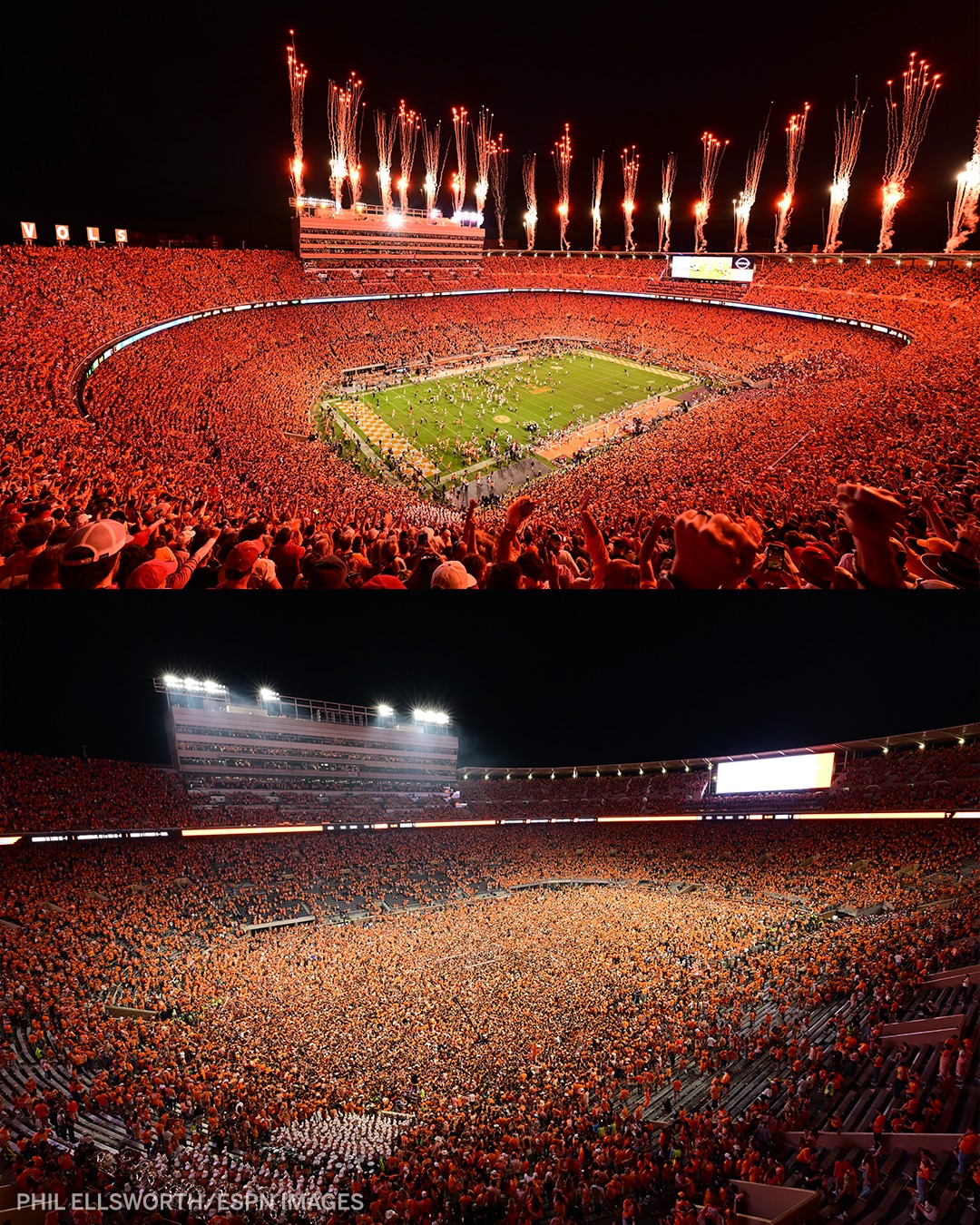
Note 5. One example of this rule of thumb in practice is the Claisen Condensation, where alkoxide bases (pKa of alcohols = 15-16) are capable of deprotonating esters (pKa = 25).
Note 6. 60 orders of magnitude is a lot. It is roughly the difference between the smallest possible length (the Planck length, about 10-35 m) and the size of the known universe (4.4 × 1026 m).
Note 7. Assuming no side reactions interfere, which is generally a good assumption since, for the most part, acid-base reactions are fast, relative to other reactions.
Quiz Yourself

Become a MOC member to see the clickable quiz with answers on the back.

Become a MOC member to see the clickable quiz with answers on the back.
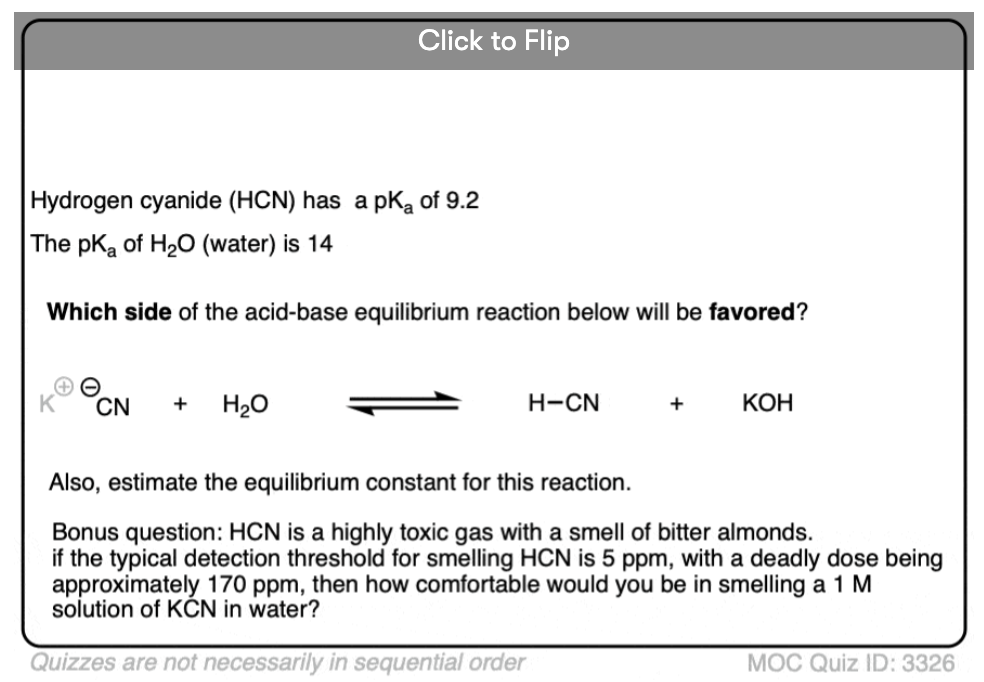
Become a MOC member to see the clickable quiz with answers on the back.
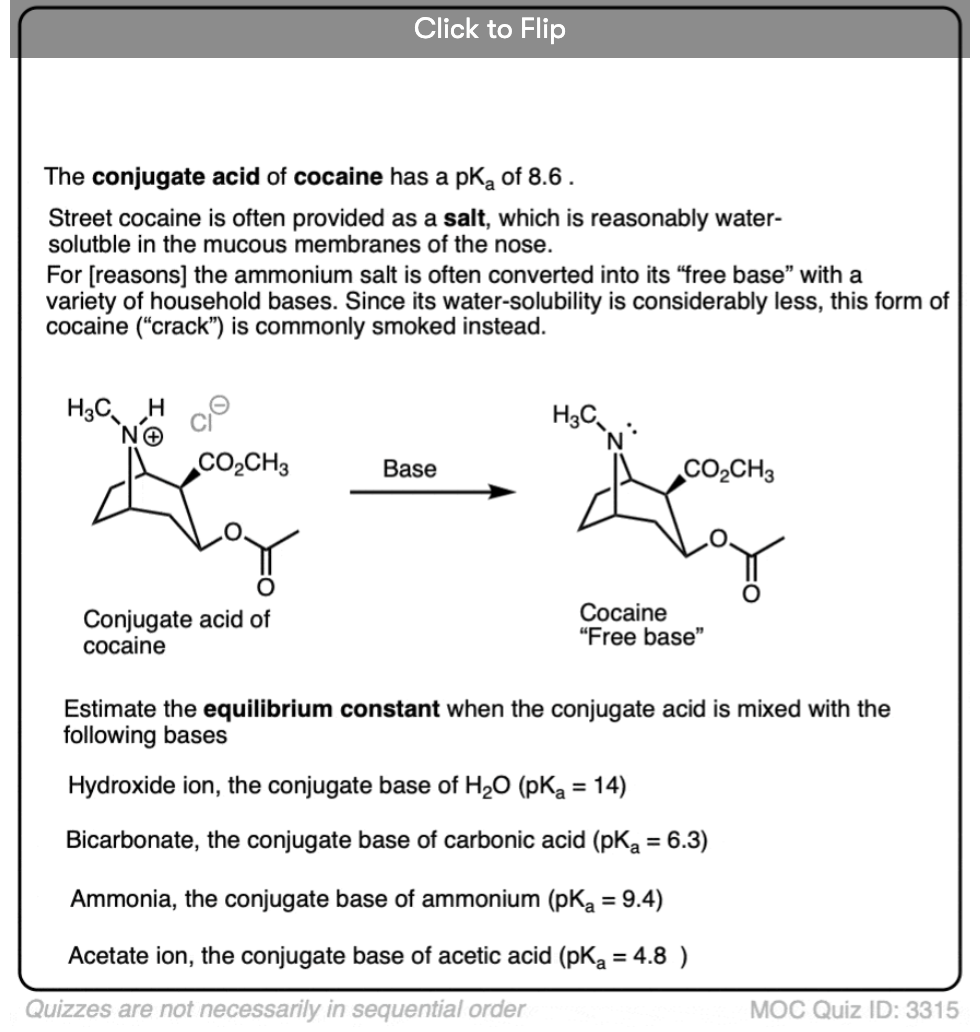
Become a MOC member to see the clickable quiz with answers on the back.
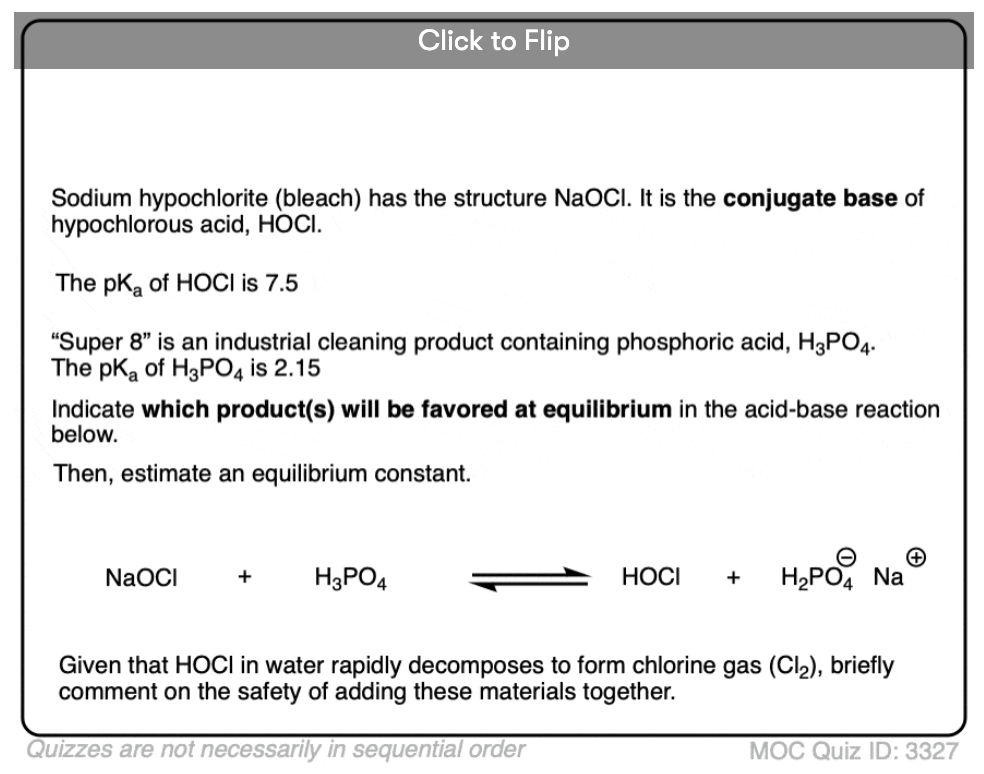
Become a MOC member to see the clickable quiz with answers on the back.
(Advanced) References and Further Reading
A collection of pKa values is presented on the Organic Chemistry Data site (formerly Hans Reich’s site)
- What Is The pKa of Water? from Libretexts is a very accessible article on this topic.
- pKa Values in the Undergraduate Curriculum: What Is the Real pKa of Water?
Todd P. Silverstein and Stephen T. Heller
Journal of Chemical Education 2017 94 (6), 690-695
DOI: 10.1021/acs.jchemed.6b00623 - Confusing Quantitative Descriptions of Brønsted-Lowry Acid-Base Equilibria in Chemistry Textbooks – A Critical Review and Clarifications for Chemical Educators
Meister, E.C., Willeke, M., Angst, W., Togni, A. and Walde, P.
Helvetica Chimica Acta, 2014 97: 1-31.
DOI: 10.1002/hlca.201300321
Full discussion of why the pKa of water (in water as solvent) should be 14.0 and the pKa of H3O(+) should be 0. - Acid Ionization Constants of Alcohols. II. Acidities of Some Substituted Methanols and Related Compounds
P. Ballinger and F. A. Long
Journal of the American Chemical Society 1960 82 (4), 795-798
DOI: 10.1021/ja01489a008
This is the paper giving the pKa of water as 15.7 whose methods are criticized in the above articles. Read it for yourself. - The Relative Acidity of Water, Methanol and Other Weak Acids in Isopropyl Alcohol Solution
Jack Hine and Mildred Hine
Journal of the American Chemical Society 1952 74 (21), 5266-5271
DOI: 10.1021/ja01141a009 - Equilibrium acidities in dimethyl sulfoxide solution
Frederick G. Bordwell
Accounts of Chemical Research 1988 21 (12), 456-463
DOI: 10.1021/ar00156a004
A very accessible account on the measurement of pKa values.
[Sigificantly updated Oct 2022]
00 General Chemistry Review
01 Bonding, Structure, and Resonance
- How Do We Know Methane (CH4) Is Tetrahedral?
- Hybrid Orbitals and Hybridization
- How To Determine Hybridization: A Shortcut
- Orbital Hybridization And Bond Strengths
- Sigma bonds come in six varieties: Pi bonds come in one
- A Key Skill: How to Calculate Formal Charge
- The Four Intermolecular Forces and How They Affect Boiling Points
- 3 Trends That Affect Boiling Points
- How To Use Electronegativity To Determine Electron Density (and why NOT to trust formal charge)
- Introduction to Resonance
- How To Use Curved Arrows To Interchange Resonance Forms
- Evaluating Resonance Forms (1) - The Rule of Least Charges
- How To Find The Best Resonance Structure By Applying Electronegativity
- Evaluating Resonance Structures With Negative Charges
- Evaluating Resonance Structures With Positive Charge
- Exploring Resonance: Pi-Donation
- Exploring Resonance: Pi-acceptors
- In Summary: Evaluating Resonance Structures
- Drawing Resonance Structures: 3 Common Mistakes To Avoid
- How to apply electronegativity and resonance to understand reactivity
- Bond Hybridization Practice
- Structure and Bonding Practice Quizzes
- Resonance Structures Practice
02 Acid Base Reactions
- Introduction to Acid-Base Reactions
- Acid Base Reactions In Organic Chemistry
- The Stronger The Acid, The Weaker The Conjugate Base
- Walkthrough of Acid-Base Reactions (3) - Acidity Trends
- Five Key Factors That Influence Acidity
- Acid-Base Reactions: Introducing Ka and pKa
- How to Use a pKa Table
- The pKa Table Is Your Friend
- A Handy Rule of Thumb for Acid-Base Reactions
- Acid Base Reactions Are Fast
- pKa Values Span 60 Orders Of Magnitude
- How Protonation and Deprotonation Affect Reactivity
- Acid Base Practice Problems
03 Alkanes and Nomenclature
- Meet the (Most Important) Functional Groups
- Condensed Formulas: Deciphering What the Brackets Mean
- Hidden Hydrogens, Hidden Lone Pairs, Hidden Counterions
- Don't Be Futyl, Learn The Butyls
- Primary, Secondary, Tertiary, Quaternary In Organic Chemistry
- Branching, and Its Affect On Melting and Boiling Points
- The Many, Many Ways of Drawing Butane
- Wedge And Dash Convention For Tetrahedral Carbon
- Common Mistakes in Organic Chemistry: Pentavalent Carbon
- Table of Functional Group Priorities for Nomenclature
- Summary Sheet - Alkane Nomenclature
- Organic Chemistry IUPAC Nomenclature Demystified With A Simple Puzzle Piece Approach
- Boiling Point Quizzes
- Organic Chemistry Nomenclature Quizzes
04 Conformations and Cycloalkanes
- Staggered vs Eclipsed Conformations of Ethane
- Conformational Isomers of Propane
- Newman Projection of Butane (and Gauche Conformation)
- Introduction to Cycloalkanes
- Geometric Isomers In Small Rings: Cis And Trans Cycloalkanes
- Calculation of Ring Strain In Cycloalkanes
- Cycloalkanes - Ring Strain In Cyclopropane And Cyclobutane
- Cyclohexane Conformations
- Cyclohexane Chair Conformation: An Aerial Tour
- How To Draw The Cyclohexane Chair Conformation
- The Cyclohexane Chair Flip
- The Cyclohexane Chair Flip - Energy Diagram
- Substituted Cyclohexanes - Axial vs Equatorial
- Ranking The Bulkiness Of Substituents On Cyclohexanes: "A-Values"
- Cyclohexane Chair Conformation Stability: Which One Is Lower Energy?
- Fused Rings - Cis-Decalin and Trans-Decalin
- Naming Bicyclic Compounds - Fused, Bridged, and Spiro
- Bredt's Rule (And Summary of Cycloalkanes)
- Newman Projection Practice
- Cycloalkanes Practice Problems
05 A Primer On Organic Reactions
- The Most Important Question To Ask When Learning a New Reaction
- Curved Arrows (for reactions)
- Nucleophiles and Electrophiles
- The Three Classes of Nucleophiles
- Nucleophilicity vs. Basicity
- What Makes A Good Nucleophile?
- What Makes A Good Leaving Group?
- 3 Factors That Stabilize Carbocations
- Equilibrium and Energy Relationships
- 7 Factors that stabilize negative charge in organic chemistry
- 7 Factors That Stabilize Positive Charge in Organic Chemistry
- What's a Transition State?
- Hammond's Postulate
- Learning Organic Chemistry Reactions: A Checklist (PDF)
- Introduction to Oxidative Cleavage Reactions
06 Free Radical Reactions
- Bond Dissociation Energies = Homolytic Cleavage
- Free Radical Reactions
- 3 Factors That Stabilize Free Radicals
- What Factors Destabilize Free Radicals?
- Bond Strengths And Radical Stability
- Free Radical Initiation: Why Is "Light" Or "Heat" Required?
- Initiation, Propagation, Termination
- Monochlorination Products Of Propane, Pentane, And Other Alkanes
- Selectivity In Free Radical Reactions
- Selectivity in Free Radical Reactions: Bromination vs. Chlorination
- Halogenation At Tiffany's
- Allylic Bromination
- Bonus Topic: Allylic Rearrangements
- In Summary: Free Radicals
- Synthesis (2) - Reactions of Alkanes
- Free Radicals Practice Quizzes
07 Stereochemistry and Chirality
- Types of Isomers: Constitutional Isomers, Stereoisomers, Enantiomers, and Diastereomers
- How To Draw The Enantiomer Of A Chiral Molecule
- How To Draw A Bond Rotation
- Introduction to Assigning (R) and (S): The Cahn-Ingold-Prelog Rules
- Assigning Cahn-Ingold-Prelog (CIP) Priorities (2) - The Method of Dots
- Enantiomers vs Diastereomers vs The Same? Two Methods For Solving Problems
- Assigning R/S To Newman Projections (And Converting Newman To Line Diagrams)
- How To Determine R and S Configurations On A Fischer Projection
- The Meso Trap
- Optical Rotation, Optical Activity, and Specific Rotation
- Optical Purity and Enantiomeric Excess
- What's a Racemic Mixture?
- Chiral Allenes And Chiral Axes
- Stereochemistry Practice Problems and Quizzes
08 Substitution Reactions
- Nucleophilic Substitution Reactions - Introduction
- Two Types of Nucleophilic Substitution Reactions
- The SN2 Mechanism
- Why the SN2 Reaction Is Powerful
- The SN1 Mechanism
- The Conjugate Acid Is A Better Leaving Group
- Comparing the SN1 and SN2 Reactions
- Polar Protic? Polar Aprotic? Nonpolar? All About Solvents
- Steric Hindrance is Like a Fat Goalie
- Common Blind Spot: Intramolecular Reactions
- Substitution Practice - SN1
- Substitution Practice - SN2
09 Elimination Reactions
- Elimination Reactions (1): Introduction And The Key Pattern
- Elimination Reactions (2): The Zaitsev Rule
- Elimination Reactions Are Favored By Heat
- Two Elimination Reaction Patterns
- The E1 Reaction
- The E2 Mechanism
- E1 vs E2: Comparing the E1 and E2 Reactions
- Antiperiplanar Relationships: The E2 Reaction and Cyclohexane Rings
- Bulky Bases in Elimination Reactions
- Comparing the E1 vs SN1 Reactions
- Elimination (E1) Reactions With Rearrangements
- E1cB - Elimination (Unimolecular) Conjugate Base
- Elimination (E1) Practice Problems And Solutions
- Elimination (E2) Practice Problems and Solutions
10 Rearrangements
11 SN1/SN2/E1/E2 Decision
- Identifying Where Substitution and Elimination Reactions Happen
- Deciding SN1/SN2/E1/E2 (1) - The Substrate
- Deciding SN1/SN2/E1/E2 (2) - The Nucleophile/Base
- SN1 vs E1 and SN2 vs E2 : The Temperature
- Deciding SN1/SN2/E1/E2 - The Solvent
- Wrapup: The Key Factors For Determining SN1/SN2/E1/E2
- Alkyl Halide Reaction Map And Summary
- SN1 SN2 E1 E2 Practice Problems
12 Alkene Reactions
- E and Z Notation For Alkenes (+ Cis/Trans)
- Alkene Stability
- Alkene Addition Reactions: "Regioselectivity" and "Stereoselectivity" (Syn/Anti)
- Stereoselective and Stereospecific Reactions
- Hydrohalogenation of Alkenes and Markovnikov's Rule
- Hydration of Alkenes With Aqueous Acid
- Rearrangements in Alkene Addition Reactions
- Halogenation of Alkenes and Halohydrin Formation
- Oxymercuration Demercuration of Alkenes
- Hydroboration Oxidation of Alkenes
- m-CPBA (meta-chloroperoxybenzoic acid)
- OsO4 (Osmium Tetroxide) for Dihydroxylation of Alkenes
- Palladium on Carbon (Pd/C) for Catalytic Hydrogenation of Alkenes
- Cyclopropanation of Alkenes
- A Fourth Alkene Addition Pattern - Free Radical Addition
- Alkene Reactions: Ozonolysis
- Summary: Three Key Families Of Alkene Reaction Mechanisms
- Synthesis (4) - Alkene Reaction Map, Including Alkyl Halide Reactions
- Alkene Reactions Practice Problems
13 Alkyne Reactions
- Acetylides from Alkynes, And Substitution Reactions of Acetylides
- Partial Reduction of Alkynes With Lindlar's Catalyst
- Partial Reduction of Alkynes With Na/NH3 To Obtain Trans Alkenes
- Alkyne Hydroboration With "R2BH"
- Hydration and Oxymercuration of Alkynes
- Hydrohalogenation of Alkynes
- Alkyne Halogenation: Bromination and Chlorination of Alkynes
- Alkyne Reactions - The "Concerted" Pathway
- Alkenes To Alkynes Via Halogenation And Elimination Reactions
- Alkynes Are A Blank Canvas
- Synthesis (5) - Reactions of Alkynes
- Alkyne Reactions Practice Problems With Answers
14 Alcohols, Epoxides and Ethers
- Alcohols - Nomenclature and Properties
- Alcohols Can Act As Acids Or Bases (And Why It Matters)
- Alcohols - Acidity and Basicity
- The Williamson Ether Synthesis
- Ethers From Alkenes, Tertiary Alkyl Halides and Alkoxymercuration
- Alcohols To Ethers via Acid Catalysis
- Cleavage Of Ethers With Acid
- Epoxides - The Outlier Of The Ether Family
- Opening of Epoxides With Acid
- Epoxide Ring Opening With Base
- Making Alkyl Halides From Alcohols
- Tosylates And Mesylates
- PBr3 and SOCl2
- Elimination Reactions of Alcohols
- Elimination of Alcohols To Alkenes With POCl3
- Alcohol Oxidation: "Strong" and "Weak" Oxidants
- Demystifying The Mechanisms of Alcohol Oxidations
- Protecting Groups For Alcohols
- Thiols And Thioethers
- Calculating the oxidation state of a carbon
- Oxidation and Reduction in Organic Chemistry
- Oxidation Ladders
- SOCl2 Mechanism For Alcohols To Alkyl Halides: SN2 versus SNi
- Alcohol Reactions Roadmap (PDF)
- Alcohol Reaction Practice Problems
- Epoxide Reaction Quizzes
- Oxidation and Reduction Practice Quizzes
15 Organometallics
- What's An Organometallic?
- Formation of Grignard and Organolithium Reagents
- Organometallics Are Strong Bases
- Reactions of Grignard Reagents
- Protecting Groups In Grignard Reactions
- Synthesis Problems Involving Grignard Reagents
- Grignard Reactions And Synthesis (2)
- Organocuprates (Gilman Reagents): How They're Made
- Gilman Reagents (Organocuprates): What They're Used For
- The Heck, Suzuki, and Olefin Metathesis Reactions (And Why They Don't Belong In Most Introductory Organic Chemistry Courses)
- Reaction Map: Reactions of Organometallics
- Grignard Practice Problems
16 Spectroscopy
- Degrees of Unsaturation (or IHD, Index of Hydrogen Deficiency)
- Conjugation And Color (+ How Bleach Works)
- Introduction To UV-Vis Spectroscopy
- UV-Vis Spectroscopy: Absorbance of Carbonyls
- UV-Vis Spectroscopy: Practice Questions
- Bond Vibrations, Infrared Spectroscopy, and the "Ball and Spring" Model
- Infrared Spectroscopy: A Quick Primer On Interpreting Spectra
- IR Spectroscopy: 4 Practice Problems
- 1H NMR: How Many Signals?
- Homotopic, Enantiotopic, Diastereotopic
- Diastereotopic Protons in 1H NMR Spectroscopy: Examples
- 13-C NMR - How Many Signals
- Liquid Gold: Pheromones In Doe Urine
- Natural Product Isolation (1) - Extraction
- Natural Product Isolation (2) - Purification Techniques, An Overview
- Structure Determination Case Study: Deer Tarsal Gland Pheromone
17 Dienes and MO Theory
- What To Expect In Organic Chemistry 2
- Are these molecules conjugated?
- Conjugation And Resonance In Organic Chemistry
- Bonding And Antibonding Pi Orbitals
- Molecular Orbitals of The Allyl Cation, Allyl Radical, and Allyl Anion
- Pi Molecular Orbitals of Butadiene
- Reactions of Dienes: 1,2 and 1,4 Addition
- Thermodynamic and Kinetic Products
- More On 1,2 and 1,4 Additions To Dienes
- s-cis and s-trans
- The Diels-Alder Reaction
- Cyclic Dienes and Dienophiles in the Diels-Alder Reaction
- Stereochemistry of the Diels-Alder Reaction
- Exo vs Endo Products In The Diels Alder: How To Tell Them Apart
- HOMO and LUMO In the Diels Alder Reaction
- Why Are Endo vs Exo Products Favored in the Diels-Alder Reaction?
- Diels-Alder Reaction: Kinetic and Thermodynamic Control
- The Retro Diels-Alder Reaction
- The Intramolecular Diels Alder Reaction
- Regiochemistry In The Diels-Alder Reaction
- The Cope and Claisen Rearrangements
- Electrocyclic Reactions
- Electrocyclic Ring Opening And Closure (2) - Six (or Eight) Pi Electrons
- Diels Alder Practice Problems
- Molecular Orbital Theory Practice
18 Aromaticity
- Introduction To Aromaticity
- Rules For Aromaticity
- Huckel's Rule: What Does 4n+2 Mean?
- Aromatic, Non-Aromatic, or Antiaromatic? Some Practice Problems
- Antiaromatic Compounds and Antiaromaticity
- The Pi Molecular Orbitals of Benzene
- The Pi Molecular Orbitals of Cyclobutadiene
- Frost Circles
- Aromaticity Practice Quizzes
19 Reactions of Aromatic Molecules
- Electrophilic Aromatic Substitution: Introduction
- Activating and Deactivating Groups In Electrophilic Aromatic Substitution
- Electrophilic Aromatic Substitution - The Mechanism
- Ortho-, Para- and Meta- Directors in Electrophilic Aromatic Substitution
- Understanding Ortho, Para, and Meta Directors
- Why are halogens ortho- para- directors?
- Disubstituted Benzenes: The Strongest Electron-Donor "Wins"
- Electrophilic Aromatic Substitutions (1) - Halogenation of Benzene
- Electrophilic Aromatic Substitutions (2) - Nitration and Sulfonation
- EAS Reactions (3) - Friedel-Crafts Acylation and Friedel-Crafts Alkylation
- Intramolecular Friedel-Crafts Reactions
- Nucleophilic Aromatic Substitution (NAS)
- Nucleophilic Aromatic Substitution (2) - The Benzyne Mechanism
- Reactions on the "Benzylic" Carbon: Bromination And Oxidation
- The Wolff-Kishner, Clemmensen, And Other Carbonyl Reductions
- More Reactions on the Aromatic Sidechain: Reduction of Nitro Groups and the Baeyer Villiger
- Aromatic Synthesis (1) - "Order Of Operations"
- Synthesis of Benzene Derivatives (2) - Polarity Reversal
- Aromatic Synthesis (3) - Sulfonyl Blocking Groups
- Birch Reduction
- Synthesis (7): Reaction Map of Benzene and Related Aromatic Compounds
- Aromatic Reactions and Synthesis Practice
- Electrophilic Aromatic Substitution Practice Problems
20 Aldehydes and Ketones
- What's The Alpha Carbon In Carbonyl Compounds?
- Nucleophilic Addition To Carbonyls
- Aldehydes and Ketones: 14 Reactions With The Same Mechanism
- Sodium Borohydride (NaBH4) Reduction of Aldehydes and Ketones
- Grignard Reagents For Addition To Aldehydes and Ketones
- Wittig Reaction
- Hydrates, Hemiacetals, and Acetals
- Imines - Properties, Formation, Reactions, and Mechanisms
- All About Enamines
- Breaking Down Carbonyl Reaction Mechanisms: Reactions of Anionic Nucleophiles (Part 2)
- Aldehydes Ketones Reaction Practice
21 Carboxylic Acid Derivatives
- Nucleophilic Acyl Substitution (With Negatively Charged Nucleophiles)
- Addition-Elimination Mechanisms With Neutral Nucleophiles (Including Acid Catalysis)
- Basic Hydrolysis of Esters - Saponification
- Transesterification
- Proton Transfer
- Fischer Esterification - Carboxylic Acid to Ester Under Acidic Conditions
- Lithium Aluminum Hydride (LiAlH4) For Reduction of Carboxylic Acid Derivatives
- LiAlH[Ot-Bu]3 For The Reduction of Acid Halides To Aldehydes
- Di-isobutyl Aluminum Hydride (DIBAL) For The Partial Reduction of Esters and Nitriles
- Amide Hydrolysis
- Thionyl Chloride (SOCl2) And Conversion of Carboxylic Acids to Acid Halides
- Diazomethane (CH2N2)
- Carbonyl Chemistry: Learn Six Mechanisms For the Price Of One
- Making Music With Mechanisms (PADPED)
- Carboxylic Acid Derivatives Practice Questions
22 Enols and Enolates
- Keto-Enol Tautomerism
- Enolates - Formation, Stability, and Simple Reactions
- Kinetic Versus Thermodynamic Enolates
- Aldol Addition and Condensation Reactions
- Reactions of Enols - Acid-Catalyzed Aldol, Halogenation, and Mannich Reactions
- Claisen Condensation and Dieckmann Condensation
- Decarboxylation
- The Malonic Ester and Acetoacetic Ester Synthesis
- The Michael Addition Reaction and Conjugate Addition
- The Robinson Annulation
- Haloform Reaction
- The Hell–Volhard–Zelinsky Reaction
- Enols and Enolates Practice Quizzes
23 Amines
- The Amide Functional Group: Properties, Synthesis, and Nomenclature
- Basicity of Amines And pKaH
- 5 Key Basicity Trends of Amines
- The Mesomeric Effect And Aromatic Amines
- Nucleophilicity of Amines
- Alkylation of Amines (Sucks!)
- Reductive Amination
- The Gabriel Synthesis
- Some Reactions of Azides
- The Hofmann Elimination
- The Hofmann and Curtius Rearrangements
- The Cope Elimination
- Protecting Groups for Amines - Carbamates
- The Strecker Synthesis of Amino Acids
- Introduction to Peptide Synthesis
- Reactions of Diazonium Salts: Sandmeyer and Related Reactions
- Amine Practice Questions
24 Carbohydrates
- D and L Notation For Sugars
- Pyranoses and Furanoses: Ring-Chain Tautomerism In Sugars
- What is Mutarotation?
- Reducing Sugars
- The Big Damn Post Of Carbohydrate-Related Chemistry Definitions
- The Haworth Projection
- Converting a Fischer Projection To A Haworth (And Vice Versa)
- Reactions of Sugars: Glycosylation and Protection
- The Ruff Degradation and Kiliani-Fischer Synthesis
- Isoelectric Points of Amino Acids (and How To Calculate Them)
- Carbohydrates Practice
- Amino Acid Quizzes
25 Fun and Miscellaneous
- A Gallery of Some Interesting Molecules From Nature
- Screw Organic Chemistry, I'm Just Going To Write About Cats
- On Cats, Part 1: Conformations and Configurations
- On Cats, Part 2: Cat Line Diagrams
- On Cats, Part 4: Enantiocats
- On Cats, Part 6: Stereocenters
- Organic Chemistry Is Shit
- The Organic Chemistry Behind "The Pill"
- Maybe they should call them, "Formal Wins" ?
- Why Do Organic Chemists Use Kilocalories?
- The Principle of Least Effort
- Organic Chemistry GIFS - Resonance Forms
- Reproducibility In Organic Chemistry
- What Holds The Nucleus Together?
- How Reactions Are Like Music
- Organic Chemistry and the New MCAT
26 Organic Chemistry Tips and Tricks
- Common Mistakes: Formal Charges Can Mislead
- Partial Charges Give Clues About Electron Flow
- Draw The Ugly Version First
- Organic Chemistry Study Tips: Learn the Trends
- The 8 Types of Arrows In Organic Chemistry, Explained
- Top 10 Skills To Master Before An Organic Chemistry 2 Final
- Common Mistakes with Carbonyls: Carboxylic Acids... Are Acids!
- Planning Organic Synthesis With "Reaction Maps"
- Alkene Addition Pattern #1: The "Carbocation Pathway"
- Alkene Addition Pattern #2: The "Three-Membered Ring" Pathway
- Alkene Addition Pattern #3: The "Concerted" Pathway
- Number Your Carbons!
- The 4 Major Classes of Reactions in Org 1
- How (and why) electrons flow
- Grossman's Rule
- Three Exam Tips
- A 3-Step Method For Thinking Through Synthesis Problems
- Putting It Together
- Putting Diels-Alder Products in Perspective
- The Ups and Downs of Cyclohexanes
- The Most Annoying Exceptions in Org 1 (Part 1)
- The Most Annoying Exceptions in Org 1 (Part 2)
- The Marriage May Be Bad, But the Divorce Still Costs Money
- 9 Nomenclature Conventions To Know
- Nucleophile attacks Electrophile
27 Case Studies of Successful O-Chem Students
- Success Stories: How Corina Got The The "Hard" Professor - And Got An A+ Anyway
- How Helena Aced Organic Chemistry
- From a "Drop" To B+ in Org 2 – How A Hard Working Student Turned It Around
- How Serge Aced Organic Chemistry
- Success Stories: How Zach Aced Organic Chemistry 1
- Success Stories: How Kari Went From C– to B+
- How Esther Bounced Back From a "C" To Get A's In Organic Chemistry 1 And 2
- How Tyrell Got The Highest Grade In Her Organic Chemistry Course
- This Is Why Students Use Flashcards
- Success Stories: How Stu Aced Organic Chemistry
- How John Pulled Up His Organic Chemistry Exam Grades
- Success Stories: How Nathan Aced Organic Chemistry (Without It Taking Over His Life)
- How Chris Aced Org 1 and Org 2
- Interview: How Jay Got an A+ In Organic Chemistry
- How to Do Well in Organic Chemistry: One Student's Advice
- "America's Top TA" Shares His Secrets For Teaching O-Chem
- "Organic Chemistry Is Like..." - A Few Metaphors
- How To Do Well In Organic Chemistry: Advice From A Tutor
- Guest post: "I went from being afraid of tests to actually looking forward to them".
Can I ask a question about this sentence? “One example of this rule of thumb in practice is the Claisen Condensation, where alkoxide bases (pKa of alcohols = 15-16) are capable of deprotonating esters (pKa = 25).” It seems that a weaker base forms a stronger base because the esters is a weaker acid compared with alcohols so its conjugated base is stronger.
Yes. While it’s true that a weaker base forms a stronger base, it’s still an equilibrium, where the concentration of deprotonated ester is about 1 x 10-9 relative to the concentration of alkoxide. However, that deprotonated ester is then immediately consumed in a reaction (the Claisen condensation, which results in formation of an alkoxide base). As deprotonated ester is consumed, the equilibrium then re-establishes itself (Le Chatelier’s principle). In this way eventually all the ester is converted into the final reaction product.
It goes to show how fast chemical reactions can be when an equilibrium difference of 1 x 10-9 can still result in a reaction going to completion.
“Since pretty much everything is less acidic than a deprotonated alkane, this means that they can deprotonate, well, pretty much anything. [Note 7]”. Should we replace the acid with alkalinity in this sentence?
Good catch. Thank you. I re-worded the sentence to make it more clear. Much appreciated!
“Here is another examnple of a substitution reaction, known as nucleophilic acyl substitution. Don’t worry about the name or the mechanism for now.” corect ur typo
Where’s the typo? That’s what the reaction is called, but neither the name or mechanism is important for comparing the relative strengths of the bases.
Hi James, marvellous post as usual. I think I’ve spotted a tiny error. At the end of section 3 you state that “Acid base reactions will favor formation of the acid with the lower pKa value”. I think this shoudl read “…the acid with the HIGHER pKa value”, as weaker acids have higher pKa values (and lower Ka values), right? Cheers, Jamie.
Fixed. Grateful to you for spotting the typo!
Hello !
I studied chemistry a long time ago in French universities! I kept a bitter memory of the difficulties to decipher the courses of my former professors and assistants.
And yet, chemistry fascinates me! I discovered your site and I am impressed by your presentation, your pedagogy and the way you explain step by step and clearly all these notions difficult to assimilate for young students.
BRAVO and CONGRATULATIONS …. I never tire of following your posts! CONTINUE …
Thank you Mikel – I am glad you enjoy the website!
How to find pKa of OH-, hydroxide in order to say conjugate base of it is O-2, oxide.
I don’t have a good value for that. If you find one let me know.
For example A we had
weak acid+weak base->stronger acid+stronger base
You said this leads to No Reaction.
How is this the case when every reaction is in equilibrium? Are we supposed to assume that because the reactants are favored energetically( meaning they have lower energy and are thus more stable) that the equilibrium is favored so much to the left that the forward reaction is essentially zero?I only ask this question because on the “handy dandy rule page” you have A/B reactions that work and they have the same WA+WB–>SA+SB pattern.
Man I am dodo head HAH! I was looking at the NH3 on the acid side lol! Thanks!I am hope I am not the only person to make that mistake.
You say,”Our basic product, Cl(-) ranks below NH3 on our inverse pKa scale. Our product is a weaker base than NH3.”Are you saying that NH2- is what we are comparing Cl(-) to?
No, I mean we’re comparing Cl- to NH3. It’s in the table, far right, between CH3COO- and HO- .
The point of the sentence was to try to drive home the fact that the reaction follows the rule, “stronger acid plus stronger base gives weaker acid and weaker base”.
Great point. For pKas higher than that of water, DMSO is a common choice of solvent. Also, at the high end of the scale (e.g. alkanes), many of these values are “kinetic” acidities rather than true equilibria.
Values for acidity in DMSO and water can differ considerably. For our purposes here, I generally don’t go into these details.
I am very confused by all these pKa, because as long as you do not know the solvent dissociation constant they are not that useful.
What I mean is that in water the strongest acid is H3O+ and the stronger base is OH-.
Therefore IN WATER all these 38, 48, are all 15.7 and all the -8 ans so on are -1.7.
So what is the strategy?
I am very confused by all these pKa, because as long as you do not know the solvent dissociation constant they are not that useful.
What I mean is that in water the strongest acid is H3O+ and the stronger base is OH-.
Therefore IN WATER all these 38, 48, -10 are all 15.7 and all the -8 ans so on are -1.7.
So what is the strategy?
Very well done. Thanks for sharing.
This website is an excellent resource. Thank you!
2 questions:
Can diphenyl ether function as a base? If so, which is a stronger base,
diphenyl ether or diphenyl amine?
Diphenyl ether is an extremely weak base. Diphenylamine is a stronger base than diphenyl ether but surprisingly not by much.
One way to evaluate basicity is by the pKa of the conjugate acid (which I call pKaH). The pKa of the conjugate acid of diphenyl ether is about -3 or so, while the pKa of the conjugate acid of diphenylamine is 0.78. Search for the Evans pka table for the references.
Isn’t pKa of water 14 (13.995), rather than 16 (15.7)? Are all of your (and Evans’) pKa values shifted?
Thank you so much! you are the best !!! i have been struggling with acid/base since the high school now i have a better understanding of how to use the pka table to help me understand the mechanism of org. THANK YOU! :)
If it’s helpful, I’m glad to hear it. Thanks Malak!
Hi, Can you tell me a close value for pka of second dissociation of ethyne?
(HC2)- to (C2)-
The first dissociation pka is available in internet, but the second one was not available?
The inverse principle that you have posted doesn’t hold for HCN.
HCN is a weak acid.However it’s conjugate is weak base too and there are many exceptions too.
For any weak acid, the conjugate base is weak. This is a rule. HCN is not an exception.
How are you defining weak? Water can be termed a weak acid, as can essentially any proton source with a pKa higher than that of water. Yet the hydroxide ion is a strong base, defined by the fact that it is fully ionized in water.
I think you mean to say “For any weak acid, the conjugate base is strong”
That’s not true. For example, acetic acid, a weak acid, has a weak conjugate base (acetate).
Hi,
Thanks for sharing the pka in detail. I do not understand why the reaction in example 1 is not possible as CH3 (weak acid) react with HO- (weak base) to provide CH3 (strong base) and H2O (strong acid).
Please you help is appreciated.
Regards,
It’s CH4 not CH3.
I have been using this site quite a bit, even though I read book and go to class lectures, this site still has more helpful hints and details the book(Klein 2e) doesn’t even mention that would seem necessary.
You’ve done an incredible thing creating this site, thank you!
I’m glad you find it helpful Harley!
Hi, could I use pka tables to see what pka a Base e.g. must have to deprotonate an Alkohol. In principle it should be higher than 16.
thanks for providing the information about Pka ,it is very useful in the acid base reactions.
THANK YOU VERY MUCH
this article has provided a concrete way of judging an acid base reaction for which I was helplessly struggling
great site
keep maintaining and improving it
Thank you very much! This is a helpful trick for my Organic I exam!